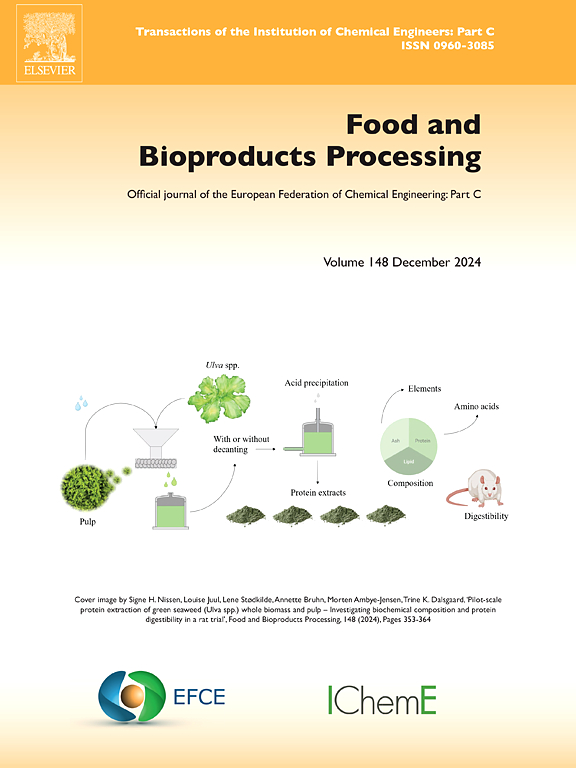菠萝汁热物理和介电性质的变化对果汁微波功率吸收密度的影响
IF 3.4
2区 农林科学
Q2 BIOTECHNOLOGY & APPLIED MICROBIOLOGY
引用次数: 0
摘要
研究了温度和浓度对10.9 ~ 50˚brix菠萝汁浓缩液(PJC)在10 ~ 60˚C温度范围内热物理和介电性能的影响。进一步采用实验和模拟技术对菠萝汁的微波吸收能力进行了评价。不同浓度和温度对菠萝汁的工程性能有显著影响(p <; 0.05)。密度随浓度增大而增大,随温度升高而减小,范围为1056.57 ~ 1203.38 kg/m3。热导率和比热随浓度减小,随温度升高而增大,分别为0.425 ~ 0.605 W/m∙K和2950.49 ~ 3860.24 J/kg∙˚C。介电常数随浓度和温度的增大而减小,范围为73.91 ~ 48.58;介电损耗因子随浓度达到45˚brix时增大,50˚brix时减小;介电损耗因子随温度的增大而减小,范围为9.67 ~ 20.23。通过多项式回归方程,菠萝汁的这些特性与温度和浓度相关(p <; 0.0001)。观察到PJC的微波功率吸收不均匀,这与PJC的介电性能有关。由于PJC的热扩散系数随浓度减小,随温度升高而增大,范围为1.52e - 1.17e -7 m2/s,低浓度时吸收的微波热在PJC内的传递效率相对较高。微波功率吸收的实测值和模拟值分别为475.2 ~ 452.2 W和464.3 ~ 449.9 W。不同浓缩物的微波功率吸收及相应的平均温度变化无显著差异(p >; 0.05)。然而,当果汁浓度从10.9˚brix增加到50˚brix时,测量和模拟的微波功率吸收分别下降了4.91 %和3.09 %。果汁的性质随着蒸发过程的进行而发生变化。浓缩方式在很大程度上影响着果汁浓缩液品质变化的方式,特别是热真空蒸发和微波辅助真空蒸发由于传热机理的不同。菠萝汁对微波功率的吸收能力不随果汁浓度的增加而明显下降,可以适当地利用微波能量进行浓缩。研究结果为微波辅助菠萝汁真空浓缩过程中微波设备的设计、工艺参数的控制和分析提供了依据。本文章由计算机程序翻译,如有差异,请以英文原文为准。
Effects of changes in thermophysical and dielectric properties of pineapple juice on microwave power absorption density of the juice
This study indicates the effects of temperature and concentration on the thermophysical and dielectric properties of pineapple juice concentrates (PJC) ranging from 10.9 to 50 ˚brix within a temperature range of 10–60˚C. Further experimental and simulation techniques were used to assess the microwave power absorption capacity of pineapple juices. The measured engineering properties of pineapple juices were influenced significantly by the different levels of concentration and temperature (p < 0.05). The density increased with concentration and decreased with temperature and ranged from 1056.57 to 1203.38 kg/m3. The thermal conductivity and specific heat decreased with concentration and increased with temperature and ranged from 0.425 to 0.605 W/m∙K and 2950.49–3860.24 J/kg∙˚C, respectively. The dielectric constants decreased with concentration and temperature and ranged from 73.91 to 48.58, and dielectric loss factor increased with concentration up to 45 ˚brix and further decreased for 50 ˚brix, and decreased with temperature, and ranged from 9.67 to 20.23. These properties of pineapple juice were correlated with temperature and concentration using polynomial regression equations (p < 0.0001). Non-uniform microwave power absorption was observed that was related with the dielectric properties of PJC. Transfer of the absorbed microwave heat within PJC was relatively efficient at lower concentration than that of at higher concentration because the thermal diffusivity of PJC decreased with concentration and increased with temperature and ranged from 1.52E-7–1.17E-7 m2/s. The measured and simulated values of microwave power absorption were ranged from 475.2 to 452.2 W and 464.3–449.9 W, respectively. The microwave power absorption at different concentrates, and corresponding average temperature change of the juices were not significantly different (p > 0.05). However, there was about 4.91 % and 3.09 % decrease in the measured and simulated microwave power absorption, respectively, as concentration of the juice increased from 10.9 to 50 ˚brix.
Practical application
The properties of fruit juice change with the progress of evaporation process. The method of concentration largely influences the way changes occur in the qualities of fruit juice concentrate especially in the case of thermal vacuum evaporation and microwave assisted vacuum evaporation due to difference in heat transfer mechanism. Pineapple juice can be suitably concentrated using microwave energy because microwave power absorption capacity of the juice does not drop significantly as concentration of the juice increases. The findings of this study facilitate in the design of microwave equipment, control and analysis of the process variables during microwave assisted vacuum concentration of pineapple juice.
求助全文
通过发布文献求助,成功后即可免费获取论文全文。
去求助
来源期刊

Food and Bioproducts Processing
工程技术-工程:化工
CiteScore
9.70
自引率
4.30%
发文量
115
审稿时长
24 days
期刊介绍:
Official Journal of the European Federation of Chemical Engineering:
Part C
FBP aims to be the principal international journal for publication of high quality, original papers in the branches of engineering and science dedicated to the safe processing of biological products. It is the only journal to exploit the synergy between biotechnology, bioprocessing and food engineering.
Papers showing how research results can be used in engineering design, and accounts of experimental or theoretical research work bringing new perspectives to established principles, highlighting unsolved problems or indicating directions for future research, are particularly welcome. Contributions that deal with new developments in equipment or processes and that can be given quantitative expression are encouraged. The journal is especially interested in papers that extend the boundaries of food and bioproducts processing.
The journal has a strong emphasis on the interface between engineering and food or bioproducts. Papers that are not likely to be published are those:
• Primarily concerned with food formulation
• That use experimental design techniques to obtain response surfaces but gain little insight from them
• That are empirical and ignore established mechanistic models, e.g., empirical drying curves
• That are primarily concerned about sensory evaluation and colour
• Concern the extraction, encapsulation and/or antioxidant activity of a specific biological material without providing insight that could be applied to a similar but different material,
• Containing only chemical analyses of biological materials.
 求助内容:
求助内容: 应助结果提醒方式:
应助结果提醒方式:


